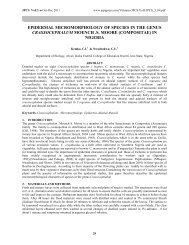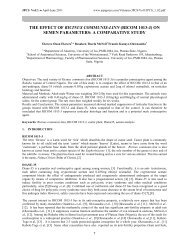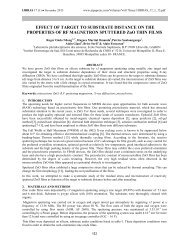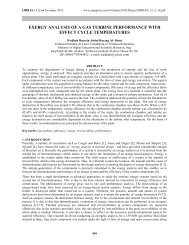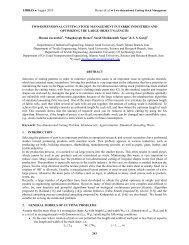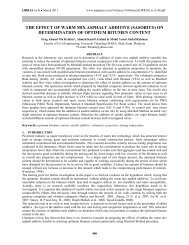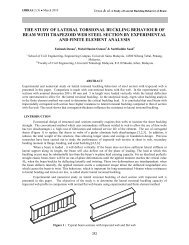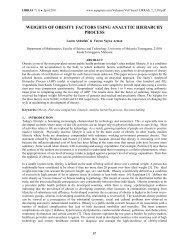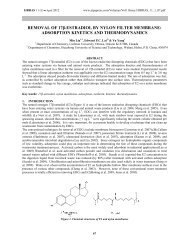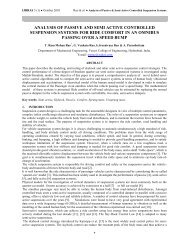elastic anisotropy of hcp metal crystals and polycrystals
elastic anisotropy of hcp metal crystals and polycrystals
elastic anisotropy of hcp metal crystals and polycrystals
You also want an ePaper? Increase the reach of your titles
YUMPU automatically turns print PDFs into web optimized ePapers that Google loves.
IJRRAS 6 (4) ● March 2011 Tromans ● Elastic Anisotropy <strong>of</strong> Hcp Metal Crystals <strong>and</strong> Poly<strong>crystals</strong><br />
S 44 S<br />
55 when referred to the transformed axes [Voigt 1928]. Furthermore, transformation <strong>of</strong> compliances to the<br />
new axes must be conducted in the full tensor notation (see Eq. (5)) after which values may be converted to the<br />
contracted matrix notation [Nye 1985]. Transformation is a tedious procedure aided by the resulting cylindrical<br />
symmetry <strong>of</strong> the compliances with respect to the c-axis <strong>of</strong> the unit cell. Calculations <strong>of</strong> the transformed compliances<br />
were first conducted by Voigt [1928, pg. 746-747] to yield Eqs. (13) <strong>and</strong> (14):<br />
x 1<br />
x<br />
x3<br />
z <br />
y<br />
N<br />
x2<br />
469<br />
x 1'<br />
x1 --<br />
[2110]<br />
[0001]<br />
x3 <br />
o<br />
(a) (b)<br />
x3'<br />
-<br />
x2 [0110]<br />
Figure 5. (a) Direction (θ degrees) <strong>of</strong> the normal N to the plane xyz with respect to X3 (b) Transformed orthogonal axes X 1 ,<br />
X 2 <strong>and</strong> 3<br />
X such that X3 is rotated by θ to coincide with N direction.<br />
4<br />
4<br />
2 2<br />
S S (sin )<br />
S (cos )<br />
( 2S<br />
S )(cos )(sin<br />
)<br />
(13)<br />
33<br />
11<br />
33<br />
13<br />
2<br />
2 2<br />
S ( <br />
G S S ) / 2 S ( S S 0.<br />
5S<br />
)(sin )<br />
2(<br />
S S 2S<br />
S )(cos sin<br />
)<br />
(14)<br />
44<br />
55<br />
44<br />
11<br />
12<br />
44<br />
Voigt’s [1928] original equations were written in terms <strong>of</strong> cos 2 θ <strong>and</strong> (1-cos 2 θ). In Eqs. (13) <strong>and</strong> (14) the original (1cos<br />
2 θ) terms have been replaced by sin 2 θ. Note that when θ equals 0 o <strong>and</strong> 90 o 1<br />
, Eq. (13) shows that ( S is<br />
equivalent to (S33) -1 <strong>and</strong> (S11) -1 , respectively, consistent with Eq. (10). Similarly, in regard to Eq. (14), G<br />
equivalent to S44 when θ = 0 o , <strong>and</strong> S G is equivalent to ( S44 2S11<br />
2S12)<br />
/ 2 when θ = 90 o , consistent with Eq. (12).<br />
44<br />
11<br />
33<br />
13<br />
44<br />
x 2'<br />
33)<br />
S is<br />
1<br />
1<br />
Based on Eqs. (13) <strong>and</strong> (14), together with the relationships E ( S33)<br />
<strong>and</strong> G ( S<br />
G ) the angular variations <strong>of</strong><br />
Young’s modulus (E ) <strong>and</strong> the shear modulus (G )for all <strong>metal</strong>s listed in Table 1 may be represented graphically, via<br />
θ versus E <strong>and</strong> θ versus G diagrams . This is shown for the three <strong>metal</strong>s Zn, Mg <strong>and</strong> Cd in Fig. 6 where the main<br />
consideration determining the combination was a reasonable similarity in magnitude between the E moduli <strong>and</strong> G<br />
moduli <strong>of</strong> each <strong>metal</strong>. It is readily evident that Zn <strong>and</strong> Cd are markedly anisotropic in behaviour, particularly Zn,<br />
whereas Mg tends to be considerably less anisotropic. Furthermore, the cylindrical symmetry <strong>of</strong> the behaviours <strong>of</strong> E<br />
<strong>and</strong> G with respect to the X3 axis (i.e. c-axis, [0001] direction) is evident in Fig 6, <strong>and</strong> evident in subsequent Figs. 7<br />
<strong>and</strong> 8, via the mirror image <strong>of</strong> the angular data on either side <strong>of</strong> the X3 axis.<br />
E (GPa)<br />
100<br />
50<br />
0<br />
Zn Zn<br />
Cd<br />
Mg<br />
X3 N - + N<br />
-90 -60 -30 0 30 60 90<br />
(degrees)<br />
Cd<br />
Mg<br />
G (GPa)<br />
50<br />
40<br />
30<br />
20<br />
10<br />
0<br />
Zn Zn<br />
Cd<br />
Mg<br />
X3 N - + N<br />
-90 -60 -30 0 30 60 90<br />
(degrees)<br />
Figure 6. Angular variation <strong>of</strong> E <strong>and</strong> G for Zn, Cd <strong>and</strong> Mg<br />
Cd<br />
Mg



